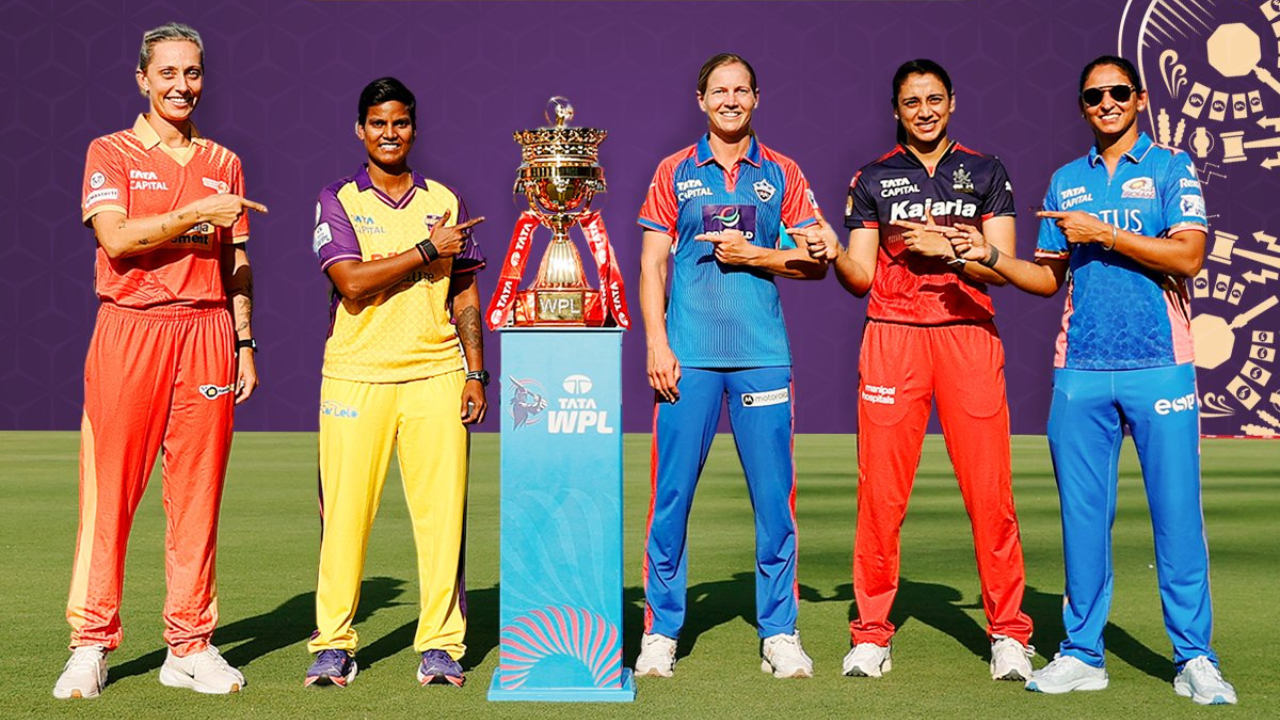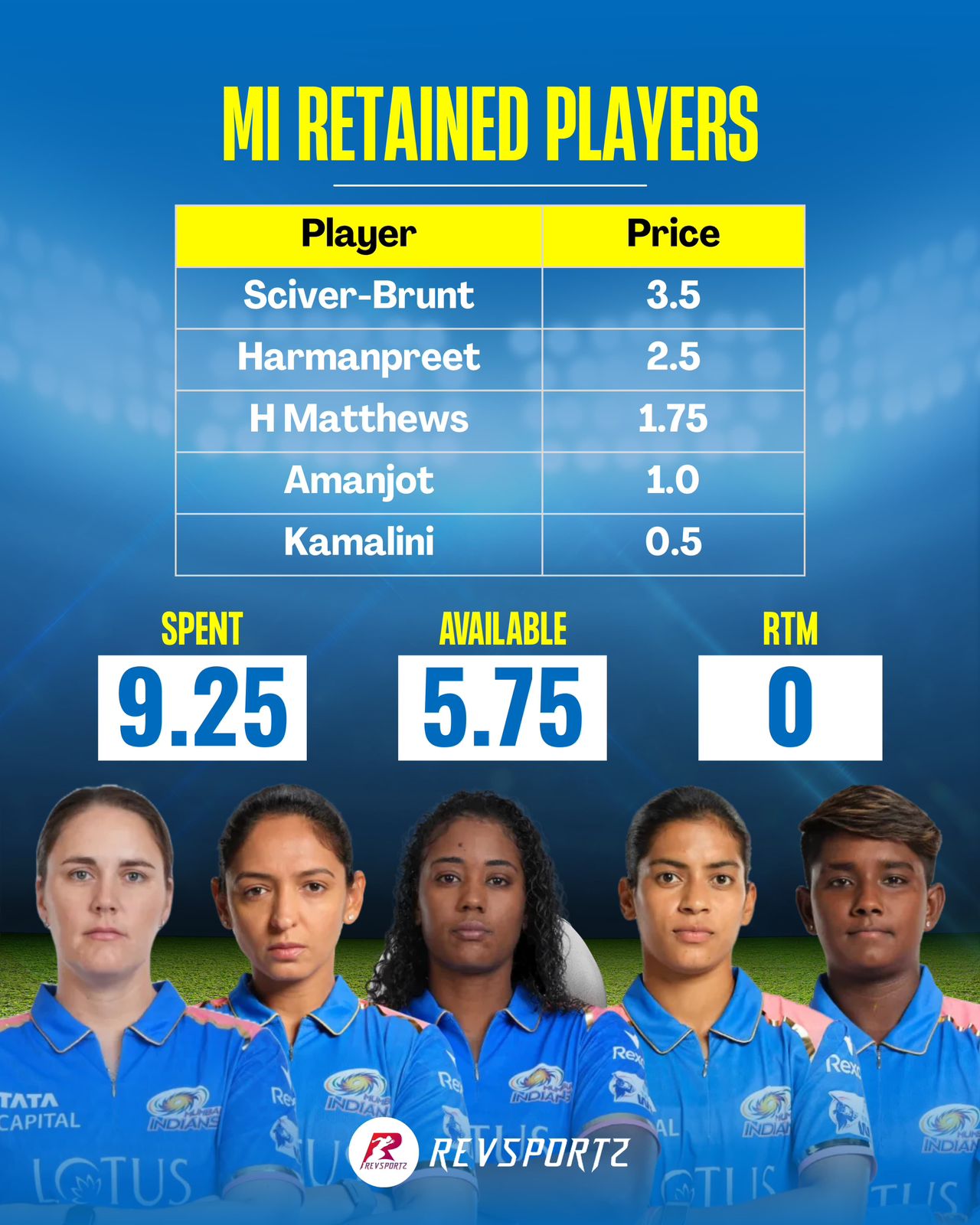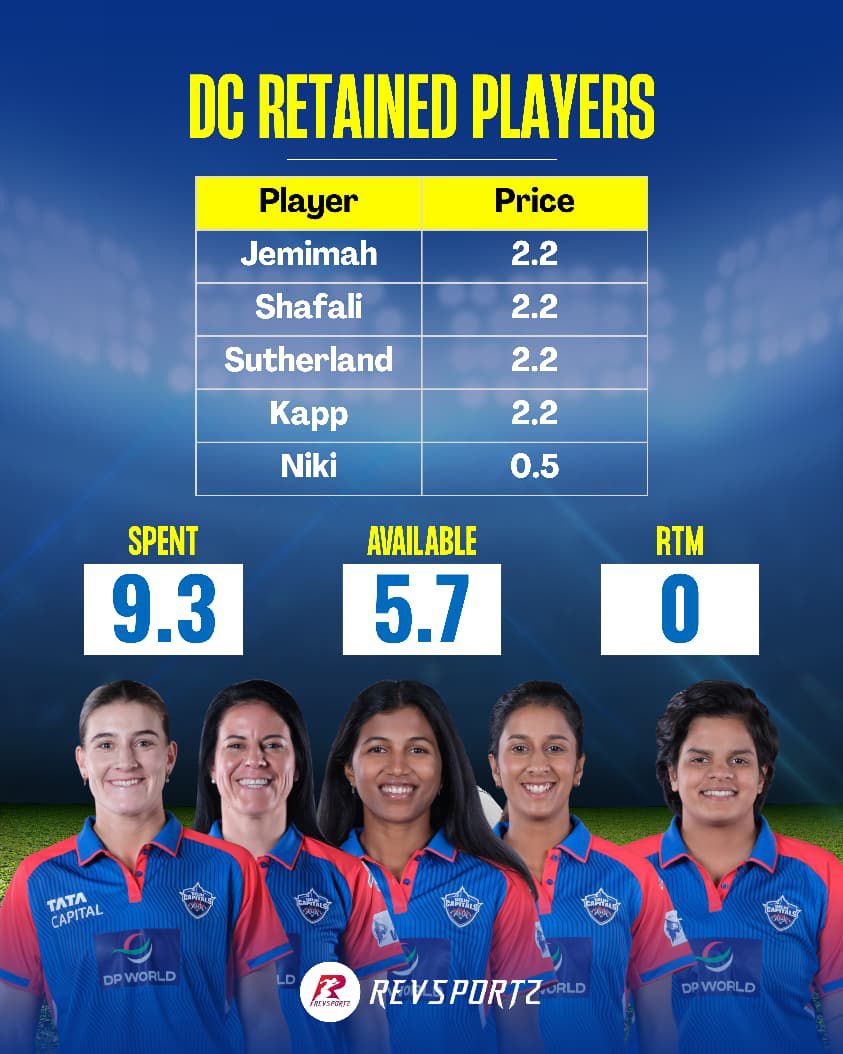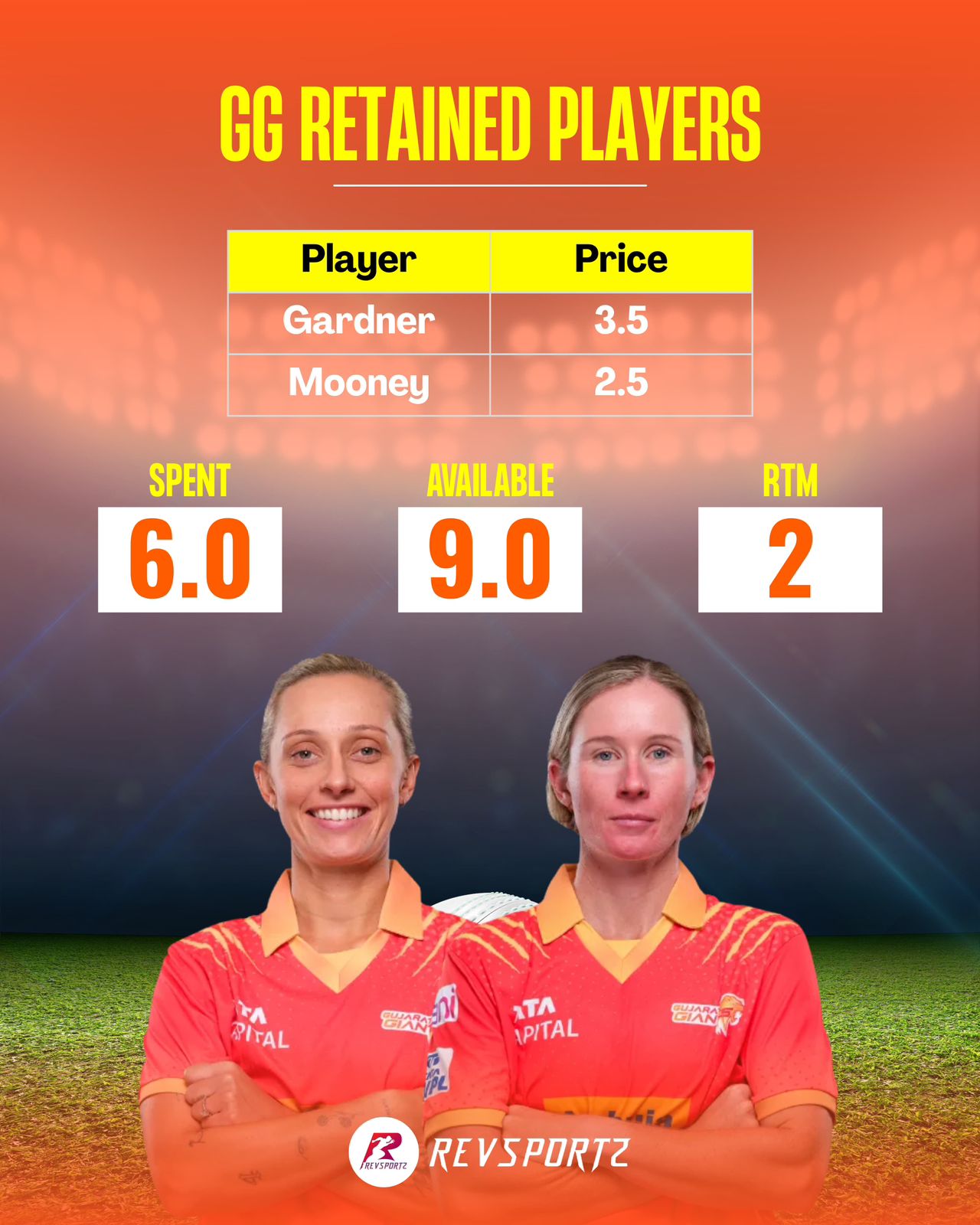
The dust has barely settled on India’s historic World Cup triumph, and yet, the women’s game barely pauses for breath. Just two days after Harmanpreet Kaur and her team lifted the coveted trophy, the cricketing spotlight has swiftly shifted to the domestic front — the Women’s Premier League. The WPL retention list for the upcoming season is out, and with it, a fresh wave of anticipation, strategy, and speculation has begun. Which franchises have chosen stability, and who have opted for bold change? Let’s start by breaking down the moves from the defending champions, Mumbai Indians.
Mumbai Indians’ Retentions: Stability, Strategy, and a Glimpse Into the Future
The defending champions Mumbai Indians have announced their retentions ahead of the upcoming WPL season, holding on to five players, Nat Sciver-Brunt (₹3.5 crore), Harmanpreet Kaur (₹2.5 crore), Hayley Matthews (₹1.75 crore), Amanjot Kaur (₹1 crore), and young wicketkeeper G. Kamalini. The total spend stands at ₹9.25 crore, leaving them with a healthy purse of ₹5.75 crore going into the auction.
Interestingly, Mumbai’s list begins not with their captain Harmanpreet Kaur but with England’s all-round powerhouse and World Cup hero Nat Sciver-Brunt. And that choice, though surprising on paper, makes tactical sense. In franchise cricket, value is determined by multi-dimensional utility. Sciver-Brunt offers four overs of seam, solidity at No. 3, and immense leadership experience, qualities that justify her premium price tag. Harmanpreet, though the face of the side and back-to-back title-winning captain (World Cup and WPL), contributes as a specialist batter and leader, hence the second-highest retention.
Matthews’ inclusion reaffirms Mumbai’s faith in proven match-winners. Despite her recent surgery, the West Indies captain remains a vital cog, an off-spinning opener who brings both aggression and experience. The choice between Matthews and Amelia Kerr was a significant one, but Kerr’s recent underwhelming performances, both in the WPL and for New Zealand, likely cost her a place. Matthews’ leadership potential and big-match temperament ultimately tilted the scales in her favour.
Amanjot’s retention highlights Mumbai’s long-standing reliance on all-rounders, a philosophy akin to the Australian model. Amanjot can deliver crucial overs through the middle and death phases while finishing with the bat, making her indispensable to the team’s balance. Kamalini, meanwhile, is the investment for the future. Mumbai have a history of nurturing raw talent, and Kamalini, a wicketkeeper-batter likely to open alongside Matthews, fits that blueprint perfectly. Her retention also explains the release of Yastika Bhatia, who has been replaced by a younger, more long-term option.
Role-wise, Mumbai already have their top order (Matthews, Kamalini, Sciver-Brunt, Harmanpreet) and a finisher (Amanjot) locked in, covering roughly 10 overs of bowling and four major batting slots. What they now need from the auction are an express pace bowler for the powerplay, a quality spinner, and an additional finisher. With ₹5.75 crore in hand, the gaps are minimal and the foundation rock-solid.
Although former England coach Lisa Keightley takes charge of the team, the retention decisions reflect a classic Mumbai Indians mindset, forward-looking, all-rounder-heavy, and development-driven. Players like Kamalini and Amanjot aren’t just short-term assets; they are pillars for the franchise’s next decade. In short, Mumbai haven’t just retained players, they’ve retained a philosophy.

Royal Challengers Bengaluru: Balancing Brand, Experience and Future Potential
Royal Challengers Bengaluru (RCB) have gone with a mix of certainty, marketability, and long-term investment in their WPL retentions, naming four players, Smriti Mandhana (₹3.5 crore), Richa Ghosh (₹2.75 crore), Ellyse Perry (₹2 crore), and Shreyanka Patil (₹60 lakh). The decisions, though largely expected, reveal a clear pattern in how RCB view their squad: built around leadership, stability, and star value.
Mandhana was always going to top the list. She’s not just RCB’s captain and opener, she’s their identity. Much like how Virat Kohli defines the men’s side, Mandhana is the face of the women’s team. She brings batting prowess, leadership, and immense brand value; a 3D cricketer who leads on and off the field. Her retention underscores RCB’s understanding of cricket as both sport and enterprise.
Richa’s retention was equally inevitable. Her explosive hitting in the lower order and growing reputation as a finisher make her indispensable. Yet, one area RCB will be keen to monitor is her wicketkeeping, where consistency remains key. With Richa likely to be their first-choice keeper again, her glovework could define several tight games.
Perry’s inclusion is a no-brainer, a seasoned pro who offers calm under pressure, top-order stability, and a few handy overs of seam. Beyond statistics, her presence gives Mandhana a sounding board on the field, especially in crunch moments. Perry’s retention also ensures that RCB maintain a leadership core built on experience and composure.
Shreyanka’s case is perhaps the most intriguing. While her on-field contributions have been solid, her inclusion feels as much about branding and fan connection as cricketing returns. Over the past years, Shreyanka has become synonymous with the RCB identity; a young, energetic all-rounder who resonates with the fan base. That said, her injury history remains a concern. RCB appear to have looked past that, betting on her potential and popularity rather than short-term fitness risk.
Off the field, RCB have undergone a coaching reshuffle. Malolan Rangarajan steps up as head coach after six years in the system, bringing familiarity and a strong domestic insight to the setup. Former England pacer Anya Shrubsole joins as bowling coach, a move that evokes memories of her battles against Mandhana in the 2017 World Cup, and now symbolises a full-circle professional partnership.
All in all, RCB’s retentions mirror a clear philosophy: Combine proven international pedigree with homegrown promise, and blend cricketing value with brand appeal. Whether that formula delivers remains to be seen, but the foundation, at least, is decisively set.

Delhi Capitals: A Bold Transition and a Glimpse Into the Future
The Delhi Capitals have announced one of the most intriguing retention lists of this WPL cycle, keeping faith in five players, Jemimah Rodrigues (₹2.2 crore), Shafali Verma (₹2.2 crore), Annabel Sutherland (₹2.2 crore), Marizanne Kapp (₹2.2 crore), and young wicketkeeper-batter Nikki Prasad (₹50 lakh). The headline, however, is what’s missing, no Meg Lanning. The captain who led them to three consecutive finals is no longer part of the setup.
While shocking on the surface, Lanning’s exclusion was expected. Having stepped away from international cricket, she often needed time to find rhythm at the start of tournaments, a luxury teams can’t afford in short leagues. Beyond that, Lanning’s value lies primarily in leadership, and paying ₹2 crore purely for captaincy doesn’t align with Delhi’s data-driven, value-conscious approach. It’s also plausible that Lanning may skip WPL 2026 altogether, making this a mutual parting rather than a tactical axing.
From the retained list, Jemimah Rodrigues appears the most likely candidate to take over the captaincy. The JSW-owned franchise has deep commercial and management ties with Jemimah, she’s not just one of their marquee Indian players but also fits the brand ethos perfectly. Shafali, meanwhile, remains indispensable as an explosive opener who can single-handedly change games. Retaining her was non-negotiable; releasing her would have meant repurchasing at a far higher price.
Sutherland’s ₹2.2 crore tag, though, raises eyebrows. While her bowling, particularly her slower variations, suits Indian conditions, her batting hasn’t been consistently impactful, barring a few standout knocks like the 96* in the World Cup. Her batting, in fact, depends heavily on conditions where the ball comes onto the bat, something that works well in Australia or England but far less so on slower subcontinental pitches. Hence, in the Indian context, Sutherland’s bowling takes precedence over her batting. The retention seems partly influenced by head coach Jonathan Batty’s familiarity with her from their Melbourne Stars days, and possibly a long-term faith in her leadership trajectory, she’s widely seen as a future Australia captain.
Kapp’s presence adds crucial balance. Her experience, consistency, and ability to deliver under pressure remain invaluable to a team transitioning into a new era. Meanwhile, the retention of Nikki Prasad is another sign of Delhi’s forward-thinking strategy, much like Mumbai’s investment in G. Kamalini. Prasad, a promising young keeper-batter, represents both continuity and the franchise’s commitment to grooming future leaders.
In essence, Delhi’s retention list signals evolution over emotion. The franchise has chosen to look beyond immediate nostalgia, opting instead for a young, versatile core built around Jemimah, Shafali, and Sutherland. The decision to move on from Meg Lanning may close one glorious chapter but it unmistakably opens the next.

Gujarat Giants: A Puzzling Retention Strategy That Raises More Questions Than Answers
If Delhi Capitals’ retentions were expected, Gujarat Giants’ list comes as a shocker, only two players retained, and both Australians. Ashley Gardner stays on for ₹3.5 crore, and Beth Mooney for ₹2.5 crore. On paper, it looks like a continuation of their Australian-heavy setup, with Michael Klinger as head coach. But dig deeper, and the strategy feels questionable.
For starters, ₹3.5 crore for Gardner seems an overinvestment. Her bowling has improved, she’s slowed it down, adapted, yet in Indian conditions, overseas spinners seldom dominate against Indian batters. Her batting, too, is best suited to surfaces where the ball comes on; the quick, true pitches of Australia and England. In subcontinental T20s, however, her bowling will likely take precedence over her batting. That makes the price tag harder to justify. Frankly, Gujarat could have let her go to the auction pool and bought her back at a more reasonable figure.
Mooney’s retention is understandable, she offers leadership, wicket-keeping, and top-order stability. If she captains, the decision holds merit. But her long-term availability remains uncertain, especially with this being a mega-auction cycle. A younger option like Phoebe Litchfield might have been a smarter investment, offering both continuity and flair for the future.
The exclusion of Laura Wolvaardt is another head-scratcher. With an RTM card available, she could easily return, but given the Australian-heavy coaching setup, that seems unlikely. The franchise’s decision to ignore Indian domestic talent and rely almost entirely on overseas names makes the strategy even riskier.
And yes, Deandra Dottin’s name inevitably hovers but that chapter seems closed. Franchise cricket, after all, is as much about corporate value as cricketing merit. Winning matters because it drives brand equity and ROI. Teams like RCB can rely on star power, Mandhana and Perry fill stadiums and attract sponsors even in defeat. Gujarat, however, lack that kind of brand magnetism.
So unless the Giants win this season, their returns, both on-field and off-field, will be hard to justify. Right now, their retention list looks less like strategy and more like a gamble.

UP Warriorz: The Biggest Gamble of the Season, A Clean Slate or a Costly Reset?
If Gujarat Giants’ retention list was surprising, UP Warriorz have stunned everyone. The franchise has retained just one player, Shweta Sehrawat, for ₹50 lakh. No Deepti Sharma. No Alyssa Healy. No Sophie Ecclestone. No Grace Harris. It’s a clean sweep that few saw coming, and it has left the cricketing circle buzzing with questions.
The release of Deepti is particularly baffling. She was not only a key all-rounder but also one of the most consistent performers in recent times, the Player of the Tournament in the World Cup, excelling with both bat and ball. Beyond her performances, Deepti also stood out as a natural leadership candidate, someone capable of building a long-term Indian core around her. Letting go of such a player, especially in a mega-auction cycle, raises serious questions about the franchise’s direction and vision.
While releasing the overseas stars like Healy, Ecclestone, and Grace Harris could be a calculated move to buy them back through the Right-to-Match (RTM) cards, it’s still a huge gamble. Four RTMs may not be enough to recover a full core, especially when multiple franchises will target these proven match-winners.
The retention of Shweta Sehrawat alone is intriguing. Nothing against the young batter, but retention is generally about locking in a playing XI asset, not a potential backup. Shweta, much like Pratika, remains a promising but developing player. If she’s being looked at as a middle-order option, it’s an unusual decision considering the franchise has released in-form and explosive names like Kiran Navgire and Kranti Gaud.
Navgire’s omission is surprising given her blistering domestic form and power-hitting ability, the kind of player who can go bang-bang from ball one and allow someone experienced like Wolvaardt (if she is bought) to build an innings around her. Kranti Gaud’s release is equally shocking; from WPL success to domestic dominance and now a world champion for India, she epitomises the kind of rising Indian talent a team should build around.
With Abhishek Nair overseeing the setup, there’s likely a deeper strategy, perhaps a tactical auction plan to reconstruct the side. But releasing nearly the entire backbone of the squad feels like a massive risk. In a league where continuity often decides early momentum, this could either be a masterstroke or a move that leaves UP struggling to rebuild their core identity.
Right now, UP Warriorz’ retention strategy stands out as the boldest and riskiest move of WPL 2025. Whether it leads to reinvention or regret, only the auction will tell.

The Calm Before the Storm
With the mega auction scheduled for 27th November, the stage is set for what promises to be one of the most defining events in the young history of the Women’s Premier League. The retention lists have already set the tone, a mix of bold decisions, emotional calls, and tactical manoeuvres that have given fans plenty to debate.
Franchises like Delhi Capitals, Mumbai Indians, and Royal Challengers Bangalore have chosen stability, opting to retain the core that has taken them deep into the tournament in previous seasons. Their task now is more about fine-tuning, filling specific gaps and strengthening the bench to ensure balance across conditions and formats.
On the other hand, Gujarat Giants and UP Warriorz have hit the reset button. Both sides will enter the auction with the heavy responsibility of not just assembling a playing XI but building a long-term project, a team capable of evolving and competing for the next four to five years. Their approach will define whether this bold gamble translates into sustained success or continued struggle.
As the countdown to the auction begins, one thing is certain, the WPL is entering a new phase. The retention lists have cleared the chessboard, and on November 27th, the franchises will make their next big moves. The battle for balance, brand, and brilliance is about to begin.
For all the updates on the WPL, follow RevSportz





